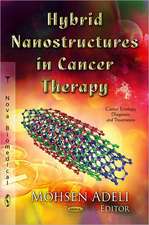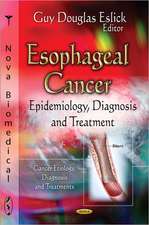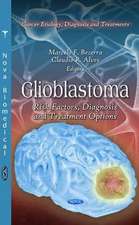Cancers in the Urban Environment: How Malignant Diseases Are Caused and Distributed among the Diverse People and Neighborhoods of a Major Global Metropolis
Autor Thomas M. Macken Limba Engleză Paperback – 2 dec 2020
Physicians and scientific investigators in California and elsewhere can use the material provided to counsel patients and evaluate the consistency of any specific pattern of occurrence with each specific causal hypothesis. A detailed appendix describes the source of data, provides the basis for the choices made in the production of the volume, and gives a perspective on the search for "clusters" of malignancy.
- Compares different types of cancers with respect to the degree of non-random occurrence
- Contains numerous maps detailing the demographic and geographic pattern of cancer occurrence in Los Angeles County
- Provides an empirical perspective on the search for disease "clusters"
Preț: 873.14 lei
Preț vechi: 1053.93 lei
-17% Nou
Puncte Express: 1310
Preț estimativ în valută:
167.09€ • 174.23$ • 138.87£
167.09€ • 174.23$ • 138.87£
Carte tipărită la comandă
Livrare economică 13-27 martie
Preluare comenzi: 021 569.72.76
Specificații
ISBN-13: 9780128117453
ISBN-10: 0128117451
Pagini: 1148
Dimensiuni: 216 x 276 mm
Ediția:2
Editura: ELSEVIER SCIENCE
ISBN-10: 0128117451
Pagini: 1148
Dimensiuni: 216 x 276 mm
Ediția:2
Editura: ELSEVIER SCIENCE
Public țintă
cancer researchers; epidemiologists; chronic disease investigators; environmental scientists; local and national government public health agencies.Cuprins
1. What Cancers Are2. Environmental and Other Causes of Cancer3. Resources Used to Detect Local Increases in Risk4. Methods Used to Detect Local Increases in Risk5. Errors Due to Chance6. Comparison Between "Apples" and "Oranges"7. Failure to Detect Local Increases in Risk8. Investigating a Lead9. Guide to the Figures10. Interpretation11. Scientific and Technical Notes12. Oropharyngeal Carcinoma13. Salivary Gland Malignancies14. Squamous Carcinoma of the Esophagus/Gastric Cardia15. Adenocarcinoma of the Esophagus/Gastric Cardia16. Adenocarcinoma of the (Lower) Stomach17. Carcinoma of the Small Intestine18. Colon Carcinoma, Total (Both Upper and Sigmoid)19. Carcinoma of the Upper Colon20. Carcinoma of the Sigmoid Colon21. Carcinoma of the Rectum22. Hepatocellular Carcinoma23. Cholangiocarcinoma24. Gallbladder Carcinoma25. Biliary Tract Carcinoma26. Pancreas Carcinoma27. Carcinoma of the Nose/Sinuses28. Carcinoma of the Larynx29. Lung and Bronchus Carcinoma, Total (All Types)30. Squamous Cell Carcinoma of the Lung and Bronchus31. Large Cell carcinoma of the Lung and Bronchus32. Small Cell Carcinoma of the Lung and Bronchus33. Adenocarcinoma of the Lung and Bronchus34. Bronchioloalveolar Carcinoma of the Lung and Bronchus35. Undifferentiated Carcinoma of the Lung and Bronchus36. Carcinoma of the Lung and Bronchus, Not Otherwise Classified37. Mesothelioma38. Soft Tissue Sarcoma39. Angiosarcoma40. Kaposi Sarcoma41. Osteosarcoma42. Ewing's Sarcoma43. Malignant Chordoma44. Malignant Melanoma45. Breast Carcinoma46. Squamous Cervix Carcinoma (Invasive)47. Endometrial (Uterine Corpus) Carcinoma48. Epithelial Carcinoma of the Ovary49. Germ Cell Malignancies50. Prostate Carcinoma51. Anogenital Adenocarcinoma52. Anogenital Squamous Carcinoma53. Mixed Cell Genital Tumors54. Transitional Cell (Non-Squamous) Bladder Carcinoma55. Squamous Bladder Carcinoma56. Renal Cell Carcinoma57. Wilms Tumor (Nephroblastoma)58. Retinoblastoma59. Brain Malignancies (Gliomas)60. Spinal Cord Malignancies61. Neurolemoma (Nerve Sheath Malignancy)62. Neuroblastoma63. Malignant Meningioma64. Papillary Carcinoma of the Thyroid65. Follicular Carcinoma of the Thyroid66. Other Carcinoma of the Thyroid67. Pituitary Carcinoma68. Multiple Endocrine Neoplasia69. Carcinoma of the Thymus70. Mixed Cellularity Hodgkin Lymphoma71. Nodular Sclerosis Hodgkin Lymphoma72. Other Hodgkin Lymphoma73. All Non-Hodgkin Lymphomas (All Non-Hodgkin Lymphoma Types)74. Follicular Non-Hodgkin Lymphoma75. Diffuse Large B-Cell Non-Hodgkin Lymphoma76. Diffuse Small Lymphocytic or Plasmacytic B-Cell Non-Hodgkin Lymphoma77. Diffuse Mixed B-Cell Non-Hodgkin Lymphoma78. High-Grade Non-Hodgkin Lymphoma79. T-Cell Non-Hodgkin Lymphoma80. Maltoma Non-Hodgkin Lymphoma81. Other Non-Hodgkin Lymphoma82. Central Nervous System Non-Hodgkin Lymphomas (All Non-Hodgkin Lymphoma Types)83. Stomach Non-Hodgkin Lymphomas (All Non-Hodgkin Lymphoma Types)84. Other Gastrointestinal Non-Hodgkin Lymphomas (All Non-Hodgkin Lymphoma Types)85. Lymph Node/Other Organ Non-Hodgkin Lymphomas (All Non-Hodgkin Lymphoma Types)86. Multiple Myeloma87. Acute Lymphoblastic Leukemia88. Chronic Lymphocytic Leukemia89. Hairy Cell Leukemia90. Acute Non-Lymphocytic Leukemia91. Chronic Myelocytic Leukemia92. Other Leukemias93. All Malignancies of Infants/Toddlers94. All Malignancies of Older Children95. All Malignancies of Young Adults96. All Malignancies of Older Adults97. All Malignancies98. Overall Summary



























